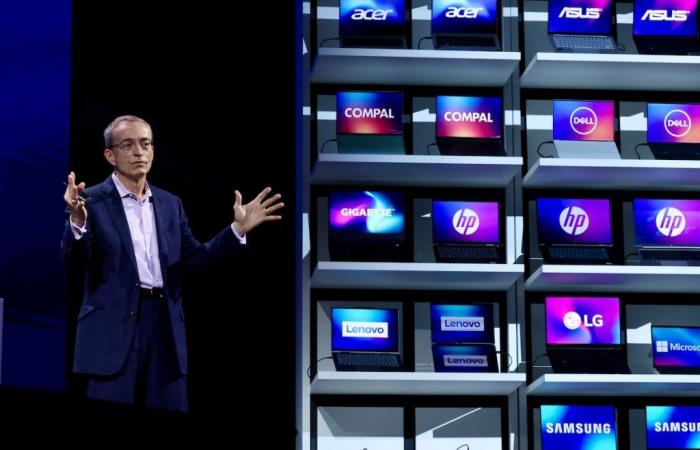
Any user who uses artificial intelligence (AI) to compose an email, write code, or generate an image is using the power of hundreds of chips thousands of miles away. Now, large semiconductor manufacturers want these complex operations to be executed from personal computers. Only unlike what happens with the processor market for these large data centers, where the American Nvidia maintains a de facto monopoly, in the world of central processing units (CPU) – the heart of laptops or desktop computers—no one has yet been able to claim the crown as AI chip designer. Intel and AMD have begun to dispute the leadership, although other rivals such as Qualcomm or MediaTek have also entered the fray, with a solid track record in the development of semiconductors for mobile phones.
eToro includes these firms among the so-called AI Big 10, firms in which they aim to position themselves in artificial intelligence to achieve broad exposure. At Computex, considered the largest fair in the sector and held every year in Taipei (Taiwan), companies have shown off what they have been cooking in their factories in recent months. Intel presented samples of laptops equipped with the brand new Lunar Lake, which debut the NPU modules. These chips will allow users to deploy Microsoft’s AI ecosystem, known as Copilot +. The assistant promises to design a PowerPoint presentation in seconds or instantly summarize long meetings via video call. “It is the most exciting moment in 25 years, since the arrival of Wi-Fi,” said Pat Gelsinger, CEO of Intel, during the fair, where he assured that Lunar Lake will appear in at least 80 models from 20 manufacturers.
Intel’s bet also seeks to catch its breath on the stock market after several years with unpromising results. At its peak, the value of each title exceeded $70, but a decade without substantial improvements in processors and serious delays in production, added to a disappointing projection of results, have been undermining the price of the company based in Santa Clara (California). So far this year it has fallen nearly 37%, while in the last five, it has fallen 35%, leaving the price close to $30 per share. In the same time, AMD shares have risen 500% and Nvidia has risen 1,800%. The latter has also managed to be crowned the most valuable company on the market, also in the heat of artificial intelligence, after unseating Microsoft from first place.
From Citi they consider that the company has a good opportunity to increase its presence in the market in 2025 but maintain a neutral rating on the value due to “too aggressive” prospects for this year. The analysis firm Huatai believes they are confident that in the future its capitalization will be close to that of its peers, “given that its market share could expand again with new launches.” Bloomberg analysts are also optimistic, although they place Intel’s recovery in the long term. “After a challenging 2024, the company is likely to bear fruit by the end of 2025 thanks to its foundry and server businesses, with tailwinds coming from AI PCs,” they explain.
The other major participant in this race to take advantage of this nascent market is AMD. The American company has just unveiled its new generation of AI microchips, the Ryzen AI 300. A new generation that will be available from July in more than 100 models. AMD has not left the manufacturing of graphics cards behind, and maintains a significant share in the data center business, which has given it the support of investors. So far this year, shares have risen 12%. Its capitalization is close to 250,000 million dollars, compared to 131,000 for Intel.
RITCHIE B. TONGO (EFE)
Apple did not want to be left behind and has accelerated the factory release of its M4 processors, also equipped with an NPU module. The new hardware It will be the base where the recently announced AI system, Apple Intelligence, will be deployed. The announcement has revived the stock of the apple company, which seemed to lack a clear roadmap for the foray into AI.
Taiwanese MediaTek would also be designing its own AI chips for PCs, according to Reuters. No company wants to be left behind in a segment that Morgan Stanley analysts point out as “key” for the next stage of sales, as the penetration of computers with AI increases from 2% in 2024 to 65% in 2028. Francisco Jerónimo, vice president of products at the technology consulting firm IDC, also considers that entering into this new segment is also a vital step in the business of these companies: “It is extremely expensive for technology companies to continue processing AI requests in their data centers. data”.
New rivals on the front
Despite everything, things are not going to be as simple as before. A new rival has emerged on the horizon to deal with from now on: Qualcomm. The American manufacturer has seen in AI the opportunity to put into practice everything learned in the automotive industry. smartphones. Its previous experience in producing powerful performance and energy-efficient chips—key aspects of bringing AI to computers—has allowed companies like Microsoft to look to the manufacturer to equip the new line of laptops. surface. “They are going to challenge Intel and AMD’s market share in the long term,” says Jeronimo.
A bet that is being well received on the stock market. Its capitalization is close to 253 million dollars, after growing 50% in the last six months. Those who previously ignored the mobile chip maker now look askance at it. “Advertising from Intel and AMD now compares their new offerings to Qualcomm’s Snapdragon This is something that shows the strength with which it has entered the market,” JP Morgan analysts share.
Despite everything, analysts predict that the real battle for the podium of chips with AI will arrive in 2025, because the first computers with this type of technology will mostly be basic models, accompanied by a scarce ecosystem of applications and with a performance of chips limited.
Ian Cutress, an analyst at the consulting firm More Than Moore, believes that it is difficult to establish a standard for who goes faster because there is still no benchmark in this segment of the industry. Consequently, “Intel, AMD and others are trying to get their foot in the door and, if possible, define the future standard for how AI is programmed into hardware” warns the expert and adds: “We will see more innovation in this market and that is what makes it exciting.”
For Jeronimo, the introduction of these chips will transform the way we relate to computers: “Now they are devices that help us create content. However, they will become terminals that know my behavior, what I do and the type of content I consume.” The head of Qualcomm, Cristiano Amon, is clear, he said at Computex that the computer industry was being reborn thanks to AI.
Follow all the information Five days in Facebook, x and Linkedinor in our newsletter Five Day Agenda
Newsletters
Sign up to receive exclusive economic information and the financial news most relevant to you
Sign up!





